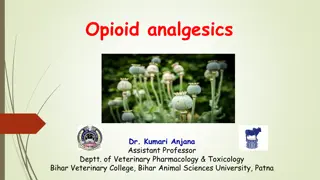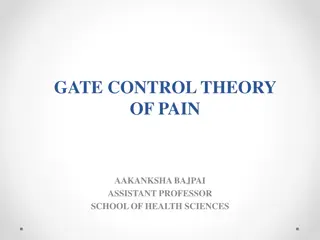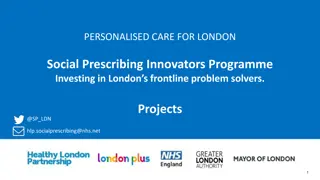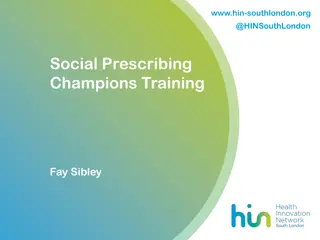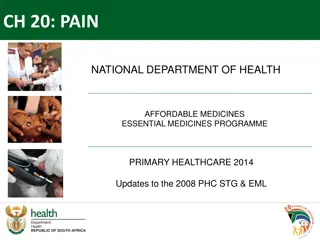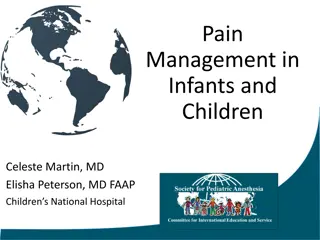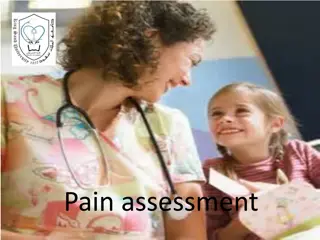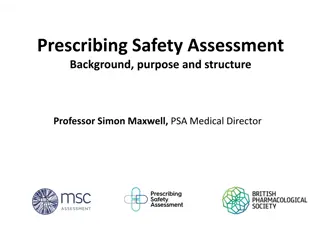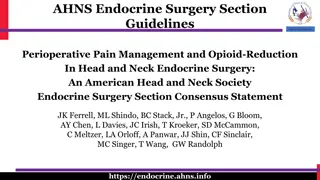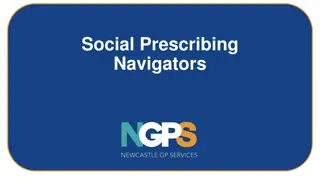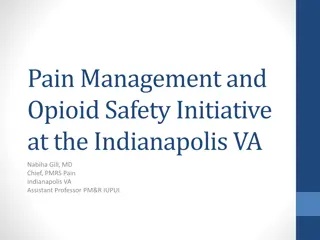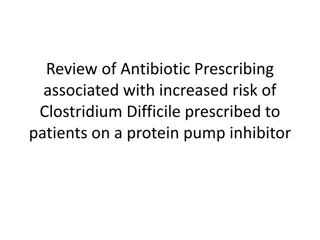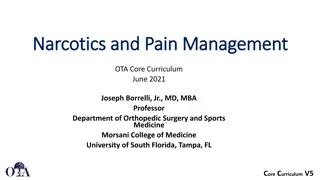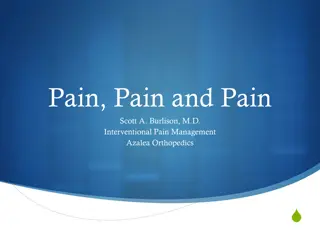Practical Aspects of Non-Medical Prescribing in In-Patient Pain Management
Exploring the challenges and strategies involved in non-medical prescribing within in-patient pain services, focusing on practicalities, education, COVID-19 symptom management, and improving prescribing practices. The content delves into the complexities of the in-patient pain service, the role of non-medical prescribers in ward rounds, communication pathways, and the need for continuous improvement through education and governance forums. Key aspects include resource limitations, interprofessional collaboration, clear communication, and adherence to best practices amidst evolving healthcare landscapes.
Download Presentation

Please find below an Image/Link to download the presentation.
The content on the website is provided AS IS for your information and personal use only. It may not be sold, licensed, or shared on other websites without obtaining consent from the author.If you encounter any issues during the download, it is possible that the publisher has removed the file from their server.
You are allowed to download the files provided on this website for personal or commercial use, subject to the condition that they are used lawfully. All files are the property of their respective owners.
The content on the website is provided AS IS for your information and personal use only. It may not be sold, licensed, or shared on other websites without obtaining consent from the author.
E N D
Presentation Transcript
Non-Medical Prescribing in an In-Patient Pain Service Liz Moir, Lead Nurse Pain Management Services
Aims: Practicalities of non-medical prescribing for inpatients with pain Non-medical prescribing as part of the ward round Improving non-medical prescribing practice within in- patient pain services COVID-19 symptom management and non-medical prescribing Developing nurse prescribing around advanced clinical practice roles Coaching and mentoring for aspiring and current non- medical prescribers
The in-patient pain service practicalities of non- medical prescribing National policy e.g. NICE Organisational restrictions: off label/non-formulary Resources e.g. nursing staff, professional development, MDT resources: psychology, physiotherapy, addiction services Lack of 24/7 cover Complex conditions Comorbidities Polypharmacy Expectation Ageing population Concordance/adherence Follow-up? Organisation / Patient external influences Competence Experience Confidence Fear Lack of autonomy Continuity Time Resources Support Responsible clinician / team Non-medical prescriber Expectation of pain team Medical model Inter/intra professional conflict Non-pharmacological acceptance Adherence Follow-up Communication Feedback
Non-medical prescribing as part of the ward round Home team ward round Follow-up Clear plan Communication Communication Clear plan Pain team input
Practicalities of ward round involvement Resources don t allow for it! Communication is key clear pathways Clear, concise pain plan Contact details IF Tools for effective communication between clinical teams e.g. e-referral, in-patient assessment/communication template Resource signposting e.g. intranet site, external agencies e.g. Turning Point, assessment tools e.g. COWS, opioid conversion tool, pain device troubleshooting.
Improving non-medical prescribing in the in-patient setting Education / CPD Clinical supervision AUDIT ERAS incorporate services Learning from errors Governance forums across specialties
Non-medical prescribing COVID-19 symptoms COVID-19: Follow RPS 10 principles: Unknown territory (ibuprofen controversy) Lack of clinical evidence Lack of best practice resources 1. Be clear reasons for prescribing 2. Medication history 3. Factors affecting risk/benefits 4. Patient concerns/expectation/ideas 5. Select effective, safe, cost-effective individualised treatments 6. Adhere to national guidelines and local formularies 7. Correct documentation, legal prescription 8. Monitor benefit, adverse effects 9. Communicate & document decisions and reasons for them 10. PRESCRIBE WITHIN LIMITS OF KNOWLEDGE, SKILLS, EXPERIENCE Rapid guidelines COVID-19 rapid guideline: Managing COVID-19 NICE guideline [NG191]Published: 23 March 2021 Last updated: 08 April 2021 (Replaces all other rapid guidelines) Managing pain in long COVID patients, impact of COVID-19 on chronic pain patients
Developing advanced roles around non-medical prescribing or developing non-medical prescribing around advanced/specialist roles? Essential requirement or expensive luxury?
Current & aspiring non-medical prescribers: coaching & mentoring Clinical supervision & continuing professional development is vital for the successful implementation of non-medical prescribing (Courtenay et al, 2018) * There is a need for improved access to clinical supervision. * There is a need for improved peer support. * There is a need for improved CPD. A proactive approach to succession planning needs to be adopted. Frontline practitioner prescribers in senior roles need to be involved in service redesign and workforce planning. Increased funding should be available for those wishing to undertake non-medical prescribing training. Study leave should be available for those wishing to undertake non-medical prescribing training
Resources for non-medical prescribers; current & aspiring NICE medicines & prescribing associates https://www.nice.org.uk/about/nice-communities/medicines-and-prescribing/nice-medicines-and-prescribing- associates#get-involved




